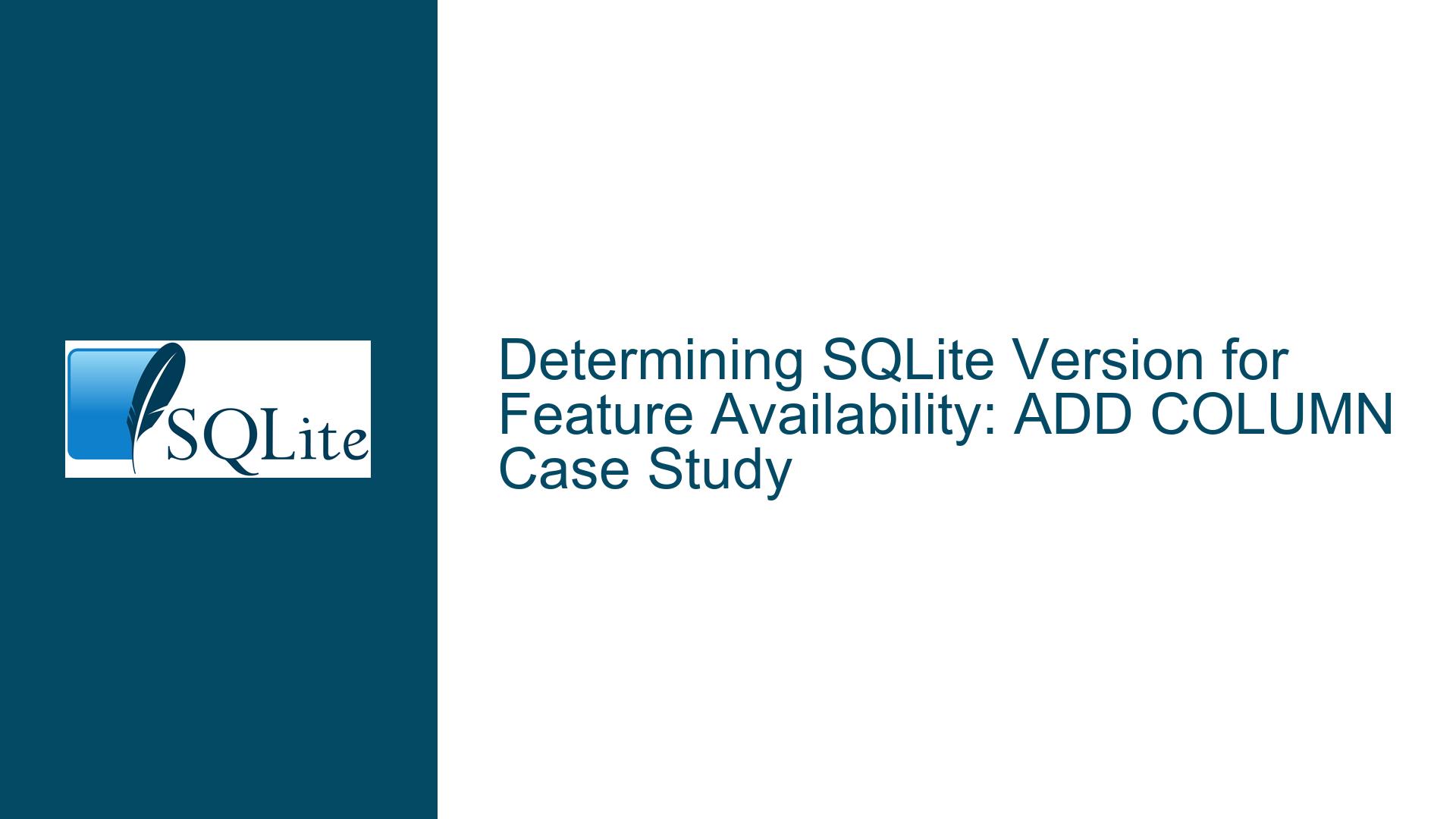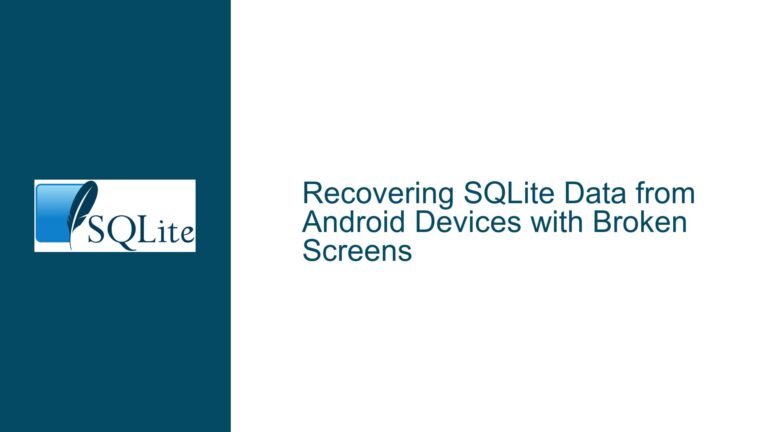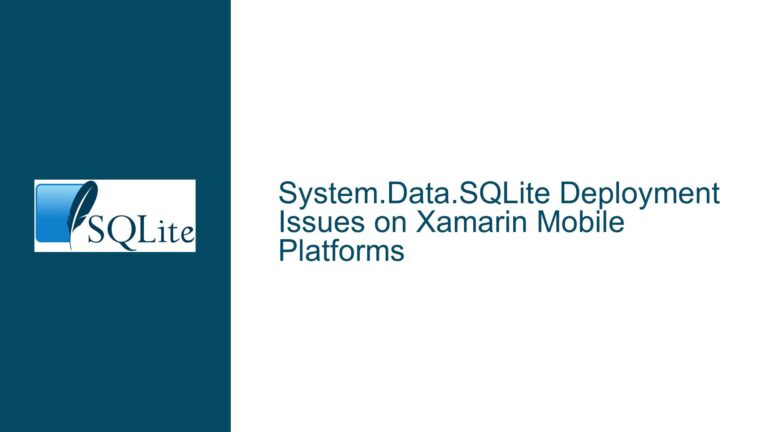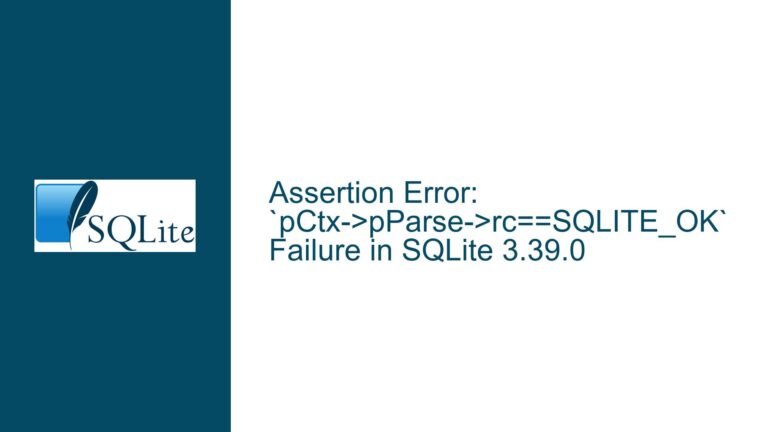Determining SQLite Version for Feature Availability: ADD COLUMN Case Study
Understanding Feature-Specific Version Requirements in SQLite
Core Challenge: Mapping SQLite Features to Minimum Supported Versions
A common challenge developers face when working with SQLite is determining the minimum version of SQLite required to use a specific feature. This issue arises when deploying applications across environments where the SQLite library is bundled with the operating system or runtime (e.g., iOS, Android, or browser-based implementations). For instance, the ALTER TABLE ... ADD COLUMN syntax is a critical feature for schema migrations, but its availability depends on the SQLite version embedded in the target environment.
The problem is multifaceted:
- Lack of Centralized Feature-Version Mapping: SQLite does not maintain an official registry that maps features to the exact version they were introduced. While the SQLite Change Log documents updates, it requires manual searching to correlate features with versions.
- Platform-Specific Bundling: SQLite versions shipped with operating systems (e.g., iOS) often lag behind the latest standalone releases. For example, iOS 15.4 bundled SQLite 3.37.0, released in November 2021, while newer versions of SQLite may include features not yet available on all devices.
- Runtime Feature Detection: Directly querying the SQLite version at runtime (
SELECT sqlite_version()) provides a version string but does not confirm whether a specific feature is enabled or supported, as platform maintainers might backport fixes without updating the version or disable features during compilation.
In the case of ALTER TABLE ... ADD COLUMN, the user needs to confirm whether all iOS deployments (dating back to older devices) include a SQLite version that supports this syntax. The consequences of misjudgment include schema migration failures, application crashes, or data corruption.
Why Feature-to-Version Mapping Is Non-Trivial in SQLite
1. Decentralized Historical Documentation
SQLite’s development history spans over two decades, with changes documented incrementally in release notes rather than a centralized feature matrix. Features like ADD COLUMN were introduced in early versions (3.2.0 in 2005), but later enhancements (e.g., ALTER TABLE ... DROP COLUMN in 3.35.0, 2021) require developers to sift through years of updates to pinpoint version boundaries.
2. Fossil SCM as the Source of Truth
The SQLite project uses Fossil SCM for version control, which contains granular commit histories. While this provides definitive timestamps for feature introductions, extracting this data requires familiarity with Fossil commands (e.g., fossil sea for searching commit messages). For example, searching for ADD COLUMN in Fossil reveals commits from March 2005, corresponding to SQLite 3.2.0. However, this approach is impractical for developers unfamiliar with Fossil or those needing rapid answers.
3. Platform Variance and Backporting Policies
Even if a feature was introduced in a specific SQLite version, platform maintainers like Apple or Google may:
- Backport security fixes without upgrading the entire SQLite version.
- Disable features via compile-time options (e.g., omitting
SQLITE_ENABLE_UPDATE_DELETE_LIMIT). - Delay updates due to compatibility testing requirements.
For instance, while ADD COLUMN has been available since 2005, a hypothetical iOS deployment using SQLite 3.1.3 (pre-3.2.0) would lack this feature. In practice, however, all iOS versions (released since 2007) include SQLite 3.2.0 or newer, making ADD COLUMN universally safe.
Strategies for Validating Feature Support in SQLite
Step 1: Leverage the SQLite Change Log
The SQLite Change Log is a chronological list of updates. To identify when a feature was added:
- Keyword Search: Use the browser’s "Find in Page" function to search for keywords like "ADD COLUMN".
- Version Correlation: Match the change description to the version number and release date. For
ADD COLUMN, the entry reads:2005-03-21 (3.2.0)
Add support for ALTER TABLE ADD COLUMN. - Cross-Referencing: Verify the feature’s stability by checking subsequent versions for related bug fixes or enhancements.
Limitations:
- The change log does not retroactively document features, requiring developers to infer version ranges.
- Minor features or internal optimizations may lack explicit mentions.
Step 2: Fossil SCM Commit History Exploration
For definitive answers, query SQLite’s Fossil repository:
Install Fossil SCM: Download and configure Fossil from https://fossil-scm.org/.
Clone the Repository:
fossil clone https://www.sqlite.org/src sqlite.fossil mkdir sqlite && cd sqlite fossil open ../sqlite.fossilSearch Commit Messages:
fossil sea 'ADD COLUMN'This returns commits where "ADD COLUMN" appears in the message, sorted chronologically. The earliest commits (e.g., 2005-03-17) indicate the feature’s introduction.
Map Commits to Releases: Cross-reference commit dates with the version history to determine the official release.
Example Output:
=== 2005-03-17 ===
05:06:28 [173e26961f] Update keyword list for ALTER TABLE ... ADD COLUMN.
05:03:39 [94185dd4f7] Add ALTER TABLE ... ADD COLUMN.
These commits preceded the 3.2.0 release (2005-03-21), confirming the feature’s availability in that version.
Step 3: Platform-Specific Version Validation
Even after confirming a feature’s introduction in a specific SQLite version, validate its availability on target platforms:
- iOS: Apple does not publish SQLite versions for each iOS release, but third-party research indicates that iOS 2.0 (2008) included SQLite 3.3.7. Since
ADD COLUMNwas added in 3.2.0, it is safe for all iOS users. - Android: The Android SDK bundles SQLite, but vendors often use outdated versions. For example, Android 4.4 (2013) shipped with SQLite 3.7.11, while Android 12 (2021) uses 3.28.0.
- Browsers: WebSQL (deprecated) implementations vary; Safari 13.1 used SQLite 3.24.0.
Mitigation Strategies:
- Runtime Version Check: Execute
SELECT sqlite_version()and parse the result. Compare against the required version (3.2.0 forADD COLUMN). - Feature Detection: Attempt a no-op
ALTER TABLEoperation in a try-catch block to test support. - Fallback Logic: If a feature is unavailable, implement alternative schema migration strategies (e.g., creating a new table and copying data).
Step 4: Compile-Time Configuration Analysis
SQLite features can be enabled or disabled via compile-time flags. For example, SQLITE_OMIT_ALTERTABLE removes ALTER TABLE support entirely. To ensure a feature is available:
- Review Platform Documentation: iOS and Android do not publicly disclose their SQLite compile-time options.
- Empirical Testing: Execute a minimal test case on target platforms. For
ADD COLUMN:CREATE TABLE test (id INTEGER); ALTER TABLE test ADD COLUMN name TEXT;If the statement succeeds, the feature is supported.
Step 5: Long-Term Maintenance and Automation
To streamline future feature-version checks:
- Maintain an Internal Database: Curate a list of critical SQLite features and their minimum versions based on historical research.
- Automate Fossil Queries: Write scripts to search Fossil commits and correlate them with releases.
- Integrate CI/CD Checks: Add runtime SQLite version validation to your build pipeline, failing deployments that target incompatible environments.
By combining these strategies, developers can confidently determine feature availability in SQLite, even in environments where version fragmentation and opaque configurations complicate direct analysis. For ALTER TABLE ... ADD COLUMN, the feature’s age and widespread adoption make it a non-issue for modern iOS apps, but the same methodology applies to newer or less common features.






